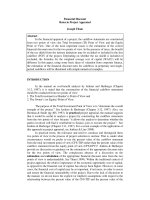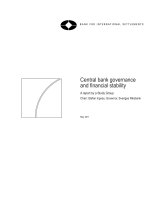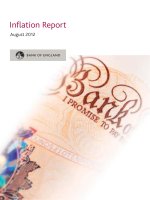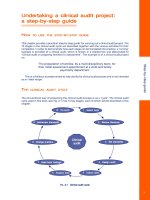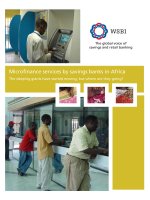Reference 1 aichi irrigation project appraisal report by world bank
Bạn đang xem bản rút gọn của tài liệu. Xem và tải ngay bản đầy đủ của tài liệu tại đây (960.25 KB, 20 trang )
Public Disclosure Authorized
Public Disclosure Authorized
Public Disclosure Authorized
E ST R I CT E D
~~~~~~~~~~~~~~~n
\
wrREpTS1 nFS}<\
FILL wrxY
r-~~H
L
eport
N
TO-147-1
r
This report was prepared for use within the Bank. In making it |
available to others, the Bank assumes no responsibility to them for
the accuracy or comnieteness of the infnrmatinn contained herein.
!.NTERNATTONA-L
BAN
FOR
I
REOSRC
ION
AND1
ZNT
-LDElVELOPMEi
REPORT ON
AICHI IRRIGATION PROJECT
JAPAN
zZ
UJ
0
co
1m1
x
Public Disclosure Authorized
y-
0
~~~
0
July 30, 1957
Department of Technical Operations
m
I
CURRENCY CONVERSIONS
US $1.00
= Yen 360
Yen 1000
= US $2.77778
Yen i million = US $2,777.78
VYn I hillinn = US $2,777,778
TABLE CF CONTENTS
pave
I.
II.
III.
IV.
V.
VI.
VII.
VIII.
IX.
Introduction
1
Need For Project
2
The Project
2
The Beneficiaries
4
Organization and M'Ianagement
5
Costs
6
Requirements and Sources of Finance
7
Benefits and Justification
8
Conclusions and Recommendations
9
AIM
_ex____
IA
.4t
I
-±iLU
T'__
A- Iflt
Annex
'B!
r
knnex 'C'
Foreign Constructioii Equipmenu
Annex 'D'
Anticipated Increase in Agricultural Production _
L z
Cosp.t, st-LBRtt,1
. In
ffi.
0-UJfi
1
-3
REFORT ON AICHI I:IRICATION FROJECT
JAPAN
1.
INTRODUCTION
1.
The Aichi Project is a four-purpose propostl comprising irrigation,
potable water sup-ly, industrial water supply and hydro-electric rower near
Nagoya, third lar&est city in Japan. The project has been uncer discussion
in Japan for many years but comrlex engineering and financial rroblems have
hitherto rrevented action. Total cost at rresent prices is estimEted at
about $101 million equivelent of which about $7 million would be needed in
foreign currency to purchase construction machinery and to pay for foreign
engineering services. About four years would be recuired to complete the
project.
2.
The project would be constructed end operated by the Aichi Irrigation Public Corporationj agovenmPnt. naenu PetphliqhPri bh scial lew
in AuEust 1955 to plan, construct and operate the Aichi Project. The Corporation is authorized to borrow money end would be the borrower of a Bank
loan with Government euarantee.
3.
Aichi was one of three agricultural i-rojects selected by the Bank
missior. of 1954
as
sl,owinr
for
,,
po6i..iliie
1-rnk
fr.
n
r
*cie
Lxvntherwa
the Land Reclamation Project for which a loan was granted December 19, 1956
-nd the +th4
w
ha
WX,1,4
-T T-_,41
.,n+ 4
ra+
h
"----r'
_A
study by Dutch consultants.
4.
ChLitLLa
Chief beneficiaries of the Aichi project would be farmers on the
Peninsula, near
Neg- y-a,jswho
l_ Ure
~unele
to
UUCL.aiu s)atisf.actorLy
'yelds'L
of crops because of chronic water shortages in the crop-growine season.
Also benefited wo-ulu be nr.-uM1ous town,s a.d v-illges in the Aichi area which
do not have any adequate supply of fresh water. The growing industrial area
arournu Nagoya likewise requires additional water anu une entire region needs
more electric power.
5.
Formal request for a Bank loan was submitted by the Aichi CorporaLion on Novemoer 9, 1955, together with a preliminary engineering report
prepared by Erik Floor and Associates Inc., Chicago, consultants engaged by
the Ministry of !£griculture and Forestry in 1954. Estimates oI agricultural
benefits from the project, prepared by the Ministry, had been submitted
previously. The Bank expressed interest in tne prorosal but since the documents furnished were insufficient for an appraisal the Bank suggested the
employment of foreign consultants to complete the plans.
In May 19569 the
Aichi Corporation re-employed the Erik Floor Company for a more detailed
engineering study and engaged an irrigation engineer, Professor A.A. Bishop
of Utah. Reports of the two consultants, together with additional information received from the Corporation, were reviewed at the Bank in January,
1957 and after some further clarification of cetails the Japanese were informed in May 1957 that the Bank was prepared to open loan negotiations.
- 2 II. NEED FOR PROJECT
Japan produces only 80 percent of her food requirements, chiefly
6.
rice, fish and vegetables. To feed 90 million people the country now
imports anrually about 5.5 million tons of food (brown rice equivalent)
By 1965, with a
costing $600 million equivalent of foreign exchange.
prospective population of 100 million, the annual food deficit will be
much greater unless production can be increased. There is thus a clear
need for increasing domestic food production by every reasonable means.
It is estimated that increased food production from the 33,000
7.
hectLres to be irrigated under the kichi Project will amount to about
100,000 tons (brown rice equivalent). Although this will meet only about
3, of the nntionnl food deficit. it will be a welcome aodition to food
supplies and is more significant for another reason. This will be the
first attempnt to deve]op irrigation on rolling unland countrv, a type of
farming new ta Japan and not common elsewhere. There are a further
200n000 hectares of similar land in southern Japnn, which. if hrought
under irrigation, would add about 600,000 tons of food (brolm rice equi+.n +to
thA natl+.onts: srlwr_
va
Tlio Lir,i; PThr;i,-e+.
t.h fnpsi+pt.
irll
bility of developing this type of upland country. If, as expected,
sati sfactcry tech>niques necessary for a new system of farming can be d-_
veloped to the extent that a production respcnse can be obtained which
would warrant further investment in upl^nd' irrigtion,
a
AJtLa.mo
significant contribution will have been made towards solution of the
SUT-3-pobem
food
na4t-on's
FLLL4...LJ
.
n
.L
U_LJI
U.
-
U
yJV L
prLovisio
±L1.1±
4.The
pLJble
WoVf1
i
s U
al
wc,MUater and. electric
power will represent incidental benefits resulting from the construction
wit r_,c~ ,tv el L
of' an irrigatilon da andi' canals., which. will be obteained"_u1
small additional cost.
III.
T nz
rsiOCnn
The law establishing the hichi Corporation gives the Corporation
9.
broad responsibility and authority to plan, construct and operate a
regional irrigatuion system and acessory works. The Corporation'3 program will bring irrigation water to 33,000 hectares of farm land, supply
45 million cuDiC meters of water to munœcipalities anrd adL about 100
million kWh per annum to the existing regional network
The proposed loan from the Bank would cover the foreign exchenge
10.
needs of essential facilities included in the program and specifically
for construction of a dam, a main canal, a regulating reservoir and a
system of secondary or distritution canals. The Bank's interest, however,
goes beyond the immediate project to the farm operations and the municipal
water and power supplies resulting from the project since these represent
the benefits coming from the program. The Bank, therefore, will need to
be kept informed concerning the progress of the program as a whole and
has obtained satisfactory assurances in this regard.
- 3 The dam located at Makio Bridge on the Ctaki River, will be 3of
11.
rock-fill construction 264 m. lon-g Al a high imrounding 75 million m of
3
water and with an effective capacity of 69 million m . A site will be
provded for a power house near the darn. From an existing barrage 120 km.
3
down river a main canal, 114 km. long and with maximum capacity of 30 m /sec.
will be constructed soauthward along the ridge of the Chita Peninsula to its
Owing to rough terrain, construction of this canal will require 35 km.
end.
of tunnels, aqueducts, siphonls and pipes. From the main canal, about 1300
km. of secondary canals will branch out over the urea to points from which
and
5 hectares of farm lanu will be irrigated. A main regula+ ng MreSer
places,
appropriate
At
several small ones will regulate flow in the cenals.
Canals will be
water will be diverted from the canals for municipal use.
will be
land
of
concrete-lined where needed. Reclamation and leveling
undertaken as necessary.
The dam and main canal will be constructed by the Aichi Corporatin
12.
under design and surervision of the Erik Floor Company. The Corporation will
also design and construct the secondary canals and will later operate the
entire system from the dam to the terminals of the secondary canals. Ditches
(or sprinkler irrigation mE.ins) leading from the encs of the secondary canals
to 22,000 farms will be designed, built and operated by legally constituted
Farmers Associations. A power house of 10,000 kw capacity and muil-cipal
water supvlv systems will be constructed by the Kensei Power Company
(a beneficiary under a previous Bank loan) End the Aichi Prefecture respectively with loans from the Corporation. These facilities will be operated
by those agencies under contracts with the Corporation.
Heavy earth and rock-moving and canal-buildine machinery required
13.
the dam, canals, and reservoirs will be imported under the
constructing
for
be purchased under international competitive bidding.
will
It
Bank loan.
and equipping the power house, water supply system
building
for
Machinery
necessary for construction of the secondary
machinery
the
of
and the bulk
work is to be rurchased in Japan.
development
land
for
canals and
IV.
THE BENEFICIARIES
Agriculture
3
33,000 hectares will receive up to 100 million m of irrigation
14.
water depending on rainfall actually received during the growing season.
17,000 hectares of rice paddies require water throughout the summer and 16,000
hectares of upland or ridRe land used for growing vegetables, fruits, winter
cereals and upland rice, require irrigation during the very dry months of
July and August. Most of the 22,000 farms involved already exist but new
farms will be established on land not now occupied. Many paddy fields in
Aichi maist now be used in wrinter to store water but with the coming of
irrigation these will be available for growing winter vegetables and cereals.
On the uplnuds, increased nroduction will come from a wider cropping pettern
and from higher yields of crops now damaged by severe drought in late summer.
- 4Paddy rice farming is an ancient and highly developed skill in Japan
and the paddy farmers should have no diffic-ulty obtaining maximum benefit
from the project almost immediately. The rapidity with which farmers can
-pl-neds is more difficult
master the intricacies of irr-iguaon on rolliHowever, Japanese
to estimate as this is a new kind of agriculture in Japan.
they can be
and
farmers are renownred for their compete.nce and diligence
in applying
gained
expected to obtain maximum yields after experience is
acquiring
in
water under these conditions. They will receive guidance
irrigation
upland
the necessary skills from the results of research into
Special
Irrigation
which has already commenced under the auspices of an Aichi
Investigation Committee organized by the Ministry of Agriculture.
15.
At the Bank's suggestion and under the guidance of Professor Bishop,
16.
plan of developing these lands by extuensive arnd costly land
original
the
leveling has been changed. The area to be leveled has been substantially
reduced in favor of the less costly and more manageable plan of irrigation
by contour furrows. Cn slopes too steep for furrows and on fields above the
canal level, sprinkler irrigation, also an innovation in Japan, will ue
employed.
The operation of an irrigation system as complex as this is also
17.
without precedent in Japan. To study irrigation project operations and
also to observe details of irrigation farming, the Corporation proposes
to send qualified technicians to the United States and elsewhere for periods
of about six months, at least one year in advance of comp]etion of the project.
It will also employ foreign irrigation consultants as needed.
18.
Municipal Water
360,000 people living in 24 towns and villages along the Chita
Peninsula are dependent on unreliable and often brackish wells for water.
The project will supply annually about 18 million m3 of water suitable for
drinking.
Factories in
expand because water
The project will add
and assure continued
19.
three industrial cities, including Nagoya, cannot
consumption is limited to 63 million m' annually.
27 million m3 of raw water annually to this supply
growth of industry.
Electric Power
The Hydro-electric potential of the Otaki and Kiso rivers is almost
ccmpletelv utilized bv 16 existing power plants but construction of the dam
will permit the addition of a small 10,000 }w plant at the dam site.
Power will he generated from water released for consumptive use in irrigation
and water supply and from special releases for power when storage is surplus
to consumptive use requirements. The project, through water regulation, will
also increase the generating capacity of the existing plants and the net
annual energy increase is estimated at about 100 million kWh. This would
add about 1.4% to the regional output of the Kansai Power Company.
-520.
Water Supplv
Hydrological calculations are based on 10 years of flow recordings
data. The calculations show that requirements for irrigation and municipal water can be met in average seasons from
the naturaL flow of the Otaki River, in, excess of existing requiremerts,
supplemented by 15 million m 3 released from the regLlating reservoirs and
20 million m3 from the dam storage. This wo-uld leave a reser-,e capacity
in the dam of 49 million m3 to take care of emergencies in dry years and
and a further 44 years of ranfall'
for power generattoni a.fter irrigati±on ad .iacpal
water requirements _re
assured.
aftl%t_.
Ul
Z
A
v .fun
sT
Pnb
T
qfu
ibl7aI
Ur,
L
ME 'U.G1'il
JAND
TT.
T,,;AATTt
The Aichi Irrigation Public Corporation
The Aichi irrigation PUDiic Corporation Law estabDlished the
21.
Corporation as a governmental agency under the general jurisdiction of the
Ministry of Agriculture and Forestry. The President of the Corporation is
appointed by the Minister of Agriculture and Forestry and up to five
Directors are appointed by the President after authorization of the Minister.
The staff is appointed by the President. The executive and technical staff
are well qualified and competent.
Subject to a power of control by the Ministry, the Corporation has
22.
sufficient powers for carrying out its program. It is authorized to borrow
from the International Bank and from the Central Government or other banking
institutions.
The Corporation maintains separate financial accounts and its
23.
anmual budget must be approved in advance by the Ministry. It is expected
to be non-profit making and self-liquidating through an elaborate system
It is empowered to impose and collect
or repayments by beneficiaries.
suoh repayments.
Consultants
The engineering consultants, Erik Floor and Associates, Inc., have
24.
been employed with the concurrence of the Bank. They are competent and their
terms of reference are adequate for proper execution of the works under their
supervision. The irrigation consultant, Professor Bishop, was also employed
with the concurrence of the Bank. He is well qualified for this work.
Arrangements for the employment of additional irrigation consultants have
not yet been completed but are being negotiated.
Contracts
Works. The works under the project will be contracted on the basis
25.
of competitive bidding and after evaluation and recommendations of the
consultant engineers. These works, which comprise the facilities down to
the discharge points of the secondary canals, will subsequently be operated
by the Cornoration.
- 6 Municipal Water Supply. Arrangements for the Aichi Prefecture to
26.
construct (with funds provided by the Corporation) and operate potable and
industrial water Lacilities are made under a contract of March 19, 1956
between the Corporation and the Prefecture. This provides for reimbursement
of the proportionate share of the Corporation's investment (at 6.5% over 20
years), and operating and maintenance expenses.
Electric Power. A contract of December 24, 1956 between the
27.
Corporation and the Kansai Power Company makes similar arrangements in
regard to electric power except that interest on the Corporationts investment
is at 7.*5.
Irrigation. Legallv binding arrangements for construction and
28.
operation of irrigation facilities beyond the ends of the secondary canals
taRke the form of Articles of Association for the Aichi Irrigation Land
Improvement District and two smaller districts covering the area benefited.
The-se Associations, formed under the Land Improvement Law, have compulsory
powers over all farmers as more than the necessary two thirds majority have
given .th.eir written- consent to cooperate. The Associations are liable to
the Corporation for payment of annual water charges. The charges are apportioned to farmers and payments so levied are collected under compulsory powers.
The Associations will constr,ct, maintain and operate the facilities
29.
beyond the ends of the secondary canals. This will be under the direction
and techn-ical supervision of the Prefect-iura! Government through its Aichi
Irrigation Section. The Corporation will assist the Prefecture on technical
aspects and the Ministry of Agiculture and Forestry will exercise overall
supervision of the irrigation program. A special Committee of representatives
of these bodies has been esta"biihed to coordinate the work.
VI.
COSTS
Detailed cost estimates for the Makio Danm, spillway and main canal
were prepared 'by Erik Floor and Associates. The estimates for the regulating
reservoirs were prepared jointly by the Consultants and the Corporation.
Those for the secondary canals -were prepared b- the Corporation it have
been checked by the Consultants. All estimates were based on unit costs
and prices in Japan on comparable work and were reviewed and checked
detail by the Japanese engineers. We believe the estimates to be realistic.
The estimated cost of the project, including interest during
31.
construction, is Yen 36,500 million ($101 million equival'ent). There is a
dollar component of $7 million, which represents machinery ($4.4 million)
foreign consultants ($1.54 million) ar,d interest during construction
(1.06 million). Details are given in Annex B.
The estimates include a contingency allowance of Yen 3800 million
32.
($10.5 million equivalent). This covers margins of 4% against possible
increases in local currency price levels plus 12% on works items against
unexpected construction difficulties.
- 7 33.
Project costs hate been allocated by Cabinet order to the three
sectorsagric lture, water -upply &nd pr. T-is
n
"Jocation Is based
on the concept of "justifiable investment" or ability to pay. Under this
cost of the project, municipal water 12.3% and power 6.3%.
RErT
UIRT1
IAR7
1TIM C'
A
C' fQ.TTnflfTIC'
KT
fTl
1'r'TAW! A
T.¶
'
34.
The cash requirements of the Corporation during the construction
period, which ends December 1960 and prior to realization of the residual
va"lue of the construction equipment, are estimated at Yen 38,398 million
($106.6 equivalent). The fund procurement plan provides for only Yen
36,415 million ($101.1 equivalent). This is because the Government is
not prepared to commit funds in advance to cover the full margin for
contingencies which the Bank considers prudent. (paragraph 32).
It is proposed, therefore, to obtain the undertaking of the Government
that such funds as are necessary to complete the project will be provided.
35.
Funds are to be provided as follows:
en
Subsidy from National Government
Figares in Millions
$ Equivalent
8,600
23.9
2,520
7.0
18,919
6j286
90
52.6
17..L
.2
Loans
IBRD
National Trust Fund Bureau and
others
P.L. L80 Counternart Funds
Outside Revenue
101.1
36.41-5
36.
The Government will contribute Yen 13,750 million as subsidy but
only Yen A-6nO million of this amount will he prrvided during the construction period.
37.
The Aichi Corporation is eligible to borrow from the National Trust
T.bmnl Pairpnii ir1por t.P-nm
of t.hni
Tt
Winln
Tsaw n+.
C
9A i ntp-rp-q+. rt-nAnnrhl a
over 20 years from 1961. This source of funds seems assured.
of Finnnnce reserves the right, h-wever, to provide money from
if needed.
The Minister
nother soure"
38.
In the original calculations most of the local currency requirement,
outide~
,
o~fs
bsidy,
Aw
iQ
to- h.aver
ber
m.e
fwrom
,'rviteypa+
e
ndsv~
available
at
4% interest from U.S. P.L. 480 surplus commodity transactions. Decision of
the Japanese Goverrent, ear-ly in 1957, to disconti-nue the pP.T. 402
agreement reduced the amount which could be allocated to this project to
,-, 6f m-1
illion.
vYen
- 8 VIII.
BENEFITS AND JUTSTIFICATION
Municiral Water
Benefits to users of potable and industrial water are not directly
39.
calculable but additional supplies are badly needed and demnnd should be
firm. Benefit to the Corporation takes the form of annual repayments by
the MUrncipalities, under contract, of prr=ortior.o sh ares of the costs
of the facilities provided. Estimates of net returns to the municipalities
show that their participation n the project w1old be profitable.
.Wlectric Power
Th1e electric pwer added to the eisting network b this project
40is relatively small but needed. Chief benefit will come from regulating
water flow in the Xiso River, thus enablhng the 16 existing plants to
maintain a steadier output. Benefit to the Corporation will be through
water and
annual repayments under contract as in the case of nicip
to
profitable
be
estimates show that participation in the project would
the Kansai Power Company.
Agriculture
Estimated market value of increased agricultural production is
41.
approximately Yen 4,800 million ($13 million equivalent) a year. This would
represent an increase of more than 60% above present production of the area.
Nearly 90% of the increase would come from rice, vegetables and fruit and
a welcome contribution would be made to food supplies. (Annex 'DI)
There is a firm basis for the estimate of increased production
42,
from 17,000 hectares of rice paddies but potential yield data for upland
insufficient for the estimate for the remaining 16,000
irrigation are still
hectares of upland country to be regarded as firm. This is because upland
i-rigation is new to Japan. The yield estimates taken are reasonable in
relation to experimental evidence gained during the last year or two.
However, only time can tell what yields the otherwise efficient Japanese
farmers will be able to attain under commercial conditions and how long
it will be before they have gained the experience necessary for maximum
yields.
Estimates of benefits to the various types of farmers have been
43.
analyzed very thoroughly by the Japanese but are subject to this same
reservation concerning the future level of upland crop yields and the
timing of its attainment. Assuming that the estimated yields are achieved,
farmers' net cash incomes per hectare -- after meeting all production costs
including labor but prior to water charges - would be increased by from
about Yen 45,000 ($125 ) to Yen 150,000 ($410 ) according to the type of
farming undertaken. This increase would be almost twice the proposed water
charges, which are to be levied according to ability to pay. Farmers will
also have to meet the costs of the Land Improvement District Associations
which represent an additional 8% or so of the expected increase in net cash
income prior to water charges.
The Corporation is to repay allocated project costs (see paragraph 33)
44.
by 1980 and is budgeting for a cash surplus of Len 2800 million at that date.
Costs allocated to power and municipal water are to be amortized over 20
years commencing 1961. Approximately half of the cost allocated to
agriculture will be met by Government subsidy. The balance will be repaid
over 10 years and in part over 15 years.
Collections from farmers will be heaviest during the first ten
45.
years. This will impose special difficulties on the upland farmers whose
yields will be low at first but will improve later as skills increase.
The Corporation is not disposed to alter the plan since the scale of
charges has been fixed by Cabinet order. They are confident that the
charges will be met because each farmer's levy will be assessed according
to ability to pay; the farmers were aware of the scale of charges when
they agreed to cooperate and were prepared to make sacrifices aver the
early years for the sake of substantial long term gains. However, since
it seems not unlikely that the early charges will prove to be too high,
the Government has undertaken to subsidize the Corporation's operations
if this should be necessary.
The substantial level of Government subsidy of this project is
46.
common to all agricultural development projects in Japan, and indeed, in
many other countries. With this subsidy as a btse, the income position
of the Corporation is satisfactory.
The Government believes thet this slubsidy is warranted by the
special need of Japan to increase food production, but as indicated in
paragraph 7, the project's experimental nature gives added and much wider
Juistif i cation.
47.
IX.
CONCLUSIONS AND RECOIRNDATIONS
The Aichi nroiect would help to satisfy an urgent need in the
4R.
Aichi Prefecture for food, water and electric power, but in a broader
way it would contribute import.ntly to Japanese knowledge of upland irriOwing to the project's experinental nature, agriculgation techniques.
tural benefits cannot be firmly assessed but there will certainly be a
material increase in production. In view of the competence of Japenese
farmers and technini8ans the chances seem to be th.t an increase in crop
yields sufficiently high to warrant the expenditure will be obtained.
If so, the way will be opened for snbseouent development of upland irrigation which would much more significently reduce the national food deficit.
The Aichi C6rporation is well organized end is staffed with
49.
competent executi-es a-nd techniciens, who are assisted by well qualified
consultants.
Operational income of the Corporation may at first be lower than
50.
estimtetd dependAing on. how raridly the newly irrigated farms get into
full production, bLt with assistance from the National Treasury if needed,
the Corior.tion would be able to meet all current obligations.
-
10
-
The machinery proposed to be purchased, both abroad and in Japan
51.
chosen and is appropriate for the project.
well
been
has
The project forms a suitable basis for a Bank loan of about
52.
$7,000,000 equivalent with a term of 20 years, including 4 years' grace.
53.
The kichi Irrigation Public Corporation is a suitable borrower.
I
1-
I
N
I
5
t0
I5
20
HaOUS
it
____f
__
0
~~~~~~~~~~~~~~~~~~
------ ------_ _ _---_ _ _ _ _ _ _ _ __-_--
__
_
DAM
___'_
25 KM
RIVER
[KANEYAMA
/
~INTAKEJAP
$y
N
JAPAN
Ivomo
A:':
141IW1-111
: RR
I6
:^I RR%p
I
iU
%fI
'DROJ'C
V"%
*-
NAGOYA
K/SO R*o8~A
Catchment Areo
R ... fit Ar.
Kom
u
Main
i
X
Ka|-
Secondory Canal
|
AIN REGULATING
Town*
@
Not all shown
30.
t
o
o
s
@
Canal
hi
*s0
ia h
4~~~~0.
\
HONSH)
\
NAREA COV/ERI
f
MAY 1957
,E s, u
d
,
,
I
132A
/
738.
X~~~~~~~~~~-"SHIKOKU\
IBRD-329
I
kNDEI Bi - pasg
COST E-ST_MTES
in
T,
A11."
~ri'1rala-~,
w.p
Cost estimate expressed in Yen and in dollar equivlents are
as follows:Finures in Millions
$ 1uixralent
Eressed in Yen
item
Dam and Spillway
Main canal
Secondary canals
Regulating Reservoirs
Land Reclamation
Power Plant
Municipal Water
Rights of Way
Corporationis overhead and expenses
Engineering, field expenses and
supervision
Contingencies
4,246
9,630
4,038
1,363
1,540
650
26.8
11.2
3.8
4.3
1.8
2,542
2,300
8.1
7.1
6.3
2,540
3,796*
7.0
10.5*
2,920
35,565
Interest during construction
11.8
2,833 *
98.7
7.9 *
Total cost of construction
Residual value of plant
38,398
1,887
106.6
5.2
Net cost of Project
36,511
101.4
Dollar expenditure included in these items represents machinery for
construction of the dam and spillway, main canal, regulating reservoirs and
land reclamation ($+.4 million), foreign engineering and irrigation consultants and associated services ($1.54 million) and interest during
construction ($1.06 million), a total of $7 million.
*
(Explanatory notes attached)
1
ANNEX 'B'
- 2 -
- page 2
Notes
Contingencies. The estimates cover a reserve of 4% on all local currency
u-.
ielvl
n loca.l crec
items agir,st
pssibe ireases
construction; 2% on foreign exchange items and 12% on all works items
agairslt
-unepetedUU
±
U
fi
ltles
duringL
Iti±UIi.
coUstou
tL shoU-UU
Utb niotuu
that the cost estimate from which the Japanese have bksed the fund procurement plan incluces a continge-ncy item of or.ly 4.2%. nowever, we
have considered it unnecessary to negotiEte a higher reserve because
of the Government assurance that all Iunds necessary wiLi be provided.
interest during construction.
Interest during construction has been
calculated up to Decem-ber 31, 1960 at the followine rates:
Bank Loan
Counterpart Fund
Trust Fund Bureau
and other loans
5-3/4% plus commitment chErge 3/4%
4%
6.5%
A^Thl.M>,V
lC !
page 1
FOREIGN CONSTRUCTION EQUIPMENT
of construction machinery
The following is the agreed list
LA.
Liu
±LL11JULJLU
L±
U1
L
±U
U.
2eLi
Dollar equivalents.
U.S. Dollar Eqiuivalent
FOR DAM & SPILLWAY
No.
Item
C.I.F.
C.I.F.
$130,000
$650,000
11,500
23,000
5
3 c.y. Power shovels
2
3 c;y. Crane booms
1
3 c.y. Dragline bucket
4,750
4,750
1
3 c.y. Clamshell bucket
6,500
6,500
12 c.y. MKotor scrapers
45,200
316,400
10
20-ton Tractor dozers
36,900
369,000
16
22-ton Dump trucks
48,000
768,000
1
16-ton Automatic compactor
30,600
30,600
1
50-ton Tire Roller
14,700
14,700
8
Diamond grout drills
2,000
16,000
4
500 g.p.M. Monitors
3,000
12,000
2
55-65 c.y. Pumperete machines
47,500
95,000
5
21 g.p.m. Grout devices
(Pumps & attachments)
9,600
48,000
7
Subtotal
$2,353,950
Spare Parts, 10%
Contingeney
235,400
$2,589,350
25,650
TOTAL. DAM & SPILLWAY
$2.615,000
-2-
ANNF X
U.S. Dollar Equivalent
Total
Unit.
C.I.F.
C.I.F.
FOR MU.IN WATERWAY
No.
_
Item
$45,200
$316,400
12 c.y. Carryall scrapers
14,000
84,000
20-tor, Tractor dozers
36,900
442,800
4
25-ton Autcmatic tire rollers
13,800
55,200
2
25 c.y. Pumperete machines
14,600
29,,200
7
12 c.y. ilotor scrapers
6
12
Subtotal
$
927,600
!#n
l95.400
$,2,nnn
12.000
Spare Parts 20%
Contingency
TOTAL, MAIN J-ATER1.JAY
$1,135,000
ANNEX IC1 - page 3
- 3 -
U.S. Dollar Equivalent
Total
Unit
C.I.F.
C.I.F.
FOR REGULATING RESERVOIR
Item
No.
$ 45,200
$271,200
20-ton Tractor dozers
36,900
73,800
25-ton Automatic tire rollers
13,80041,400
6
12 c.y. Motor scrapers
2
3
Subtotal
$386,400
Spare Parts 19.4%
75.000
$461,400
4,600
Contingency
TOThL,
REGULTING RESERVOIR $466,000
U.S. Dollar Equivalent
Total
Unit
C.I.F.
C.I.F.
FOR RECLA'.k,TION
No.
Item
3
20-ton Tractor dozers
3
Sets Plows and harrows
$36,900
$110,700
13,500
40,500
Subtotal
$151,200
Spare Parts 20.4%
Contingency
30,8CO
$182-000
1,000
TOTAL, RECLAMATION
$183,000
RSTT1VU.TF.D GOST OF ALL TTPORTEfl ERTITPNENT
Main Waterway
1,135,000
pegulating Reseroir
46,000-n
Reclamation
183,000
TCTAL -
$4,399,000
ANNEX 'D'
-
ANTICIPATED INCRLASE IN AGRICULTURAL PR'DUCTION
C.
rheors+;+sr
232,00
Pdyrice
oWshels
Upland rice
700,00
Barley
270,000
!!
'wnea;
260,coo
!1o68,COO
-
io0,OO
Beans
-
19,000
-
Sweet Potatoes
17,000,000 pounds
i;
Vegetables
Fruits
SMlberry leaves
is,uuv,OOO
Vegetable seeds
1,22,0
t
fCif
650,000
-
40,000
-
100,000
143,000
323,000
"
272,0u0,000
"
3,350,000
LZ,000,000
i
3,200,000
is
-
-
107,000
-
7,400 bushels
1,600
64,000
1S,000
55,000
.ea
Rape seed
-Rcarcnilp
36,7
Minor Cereals
White
4
nc
nQ
is
-
26,000
13,000
$13,065,000
page 1


